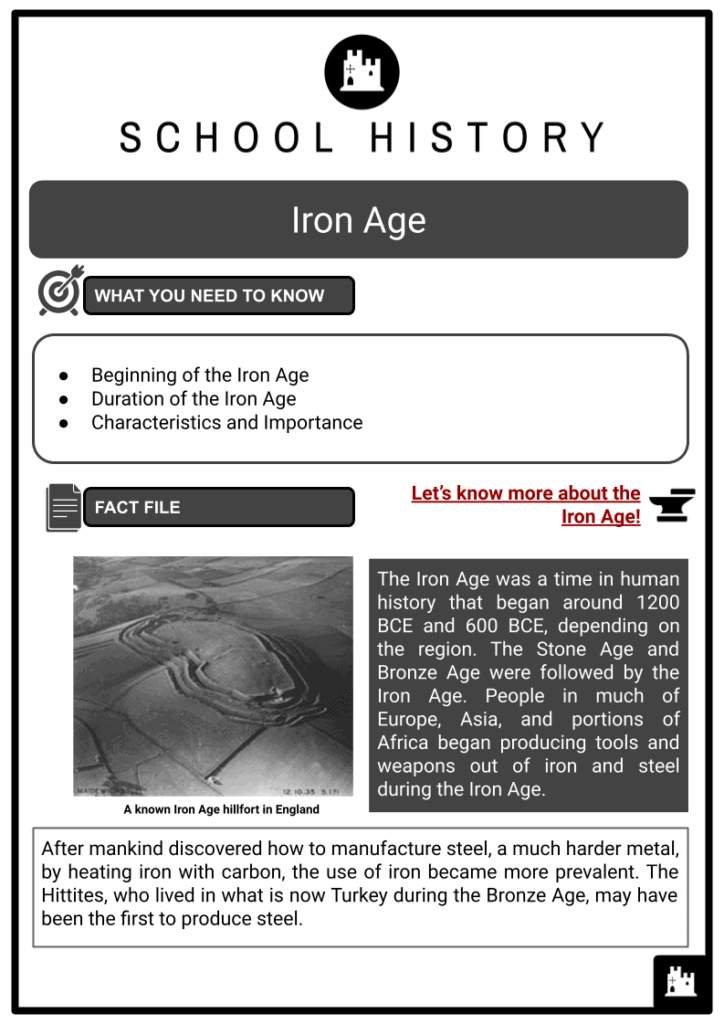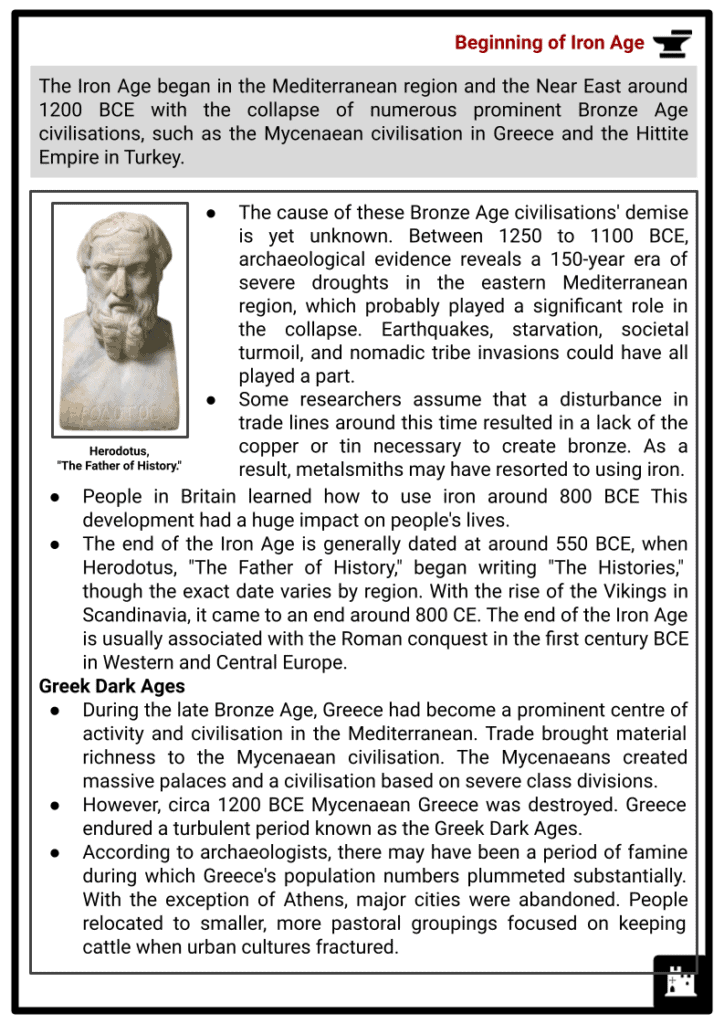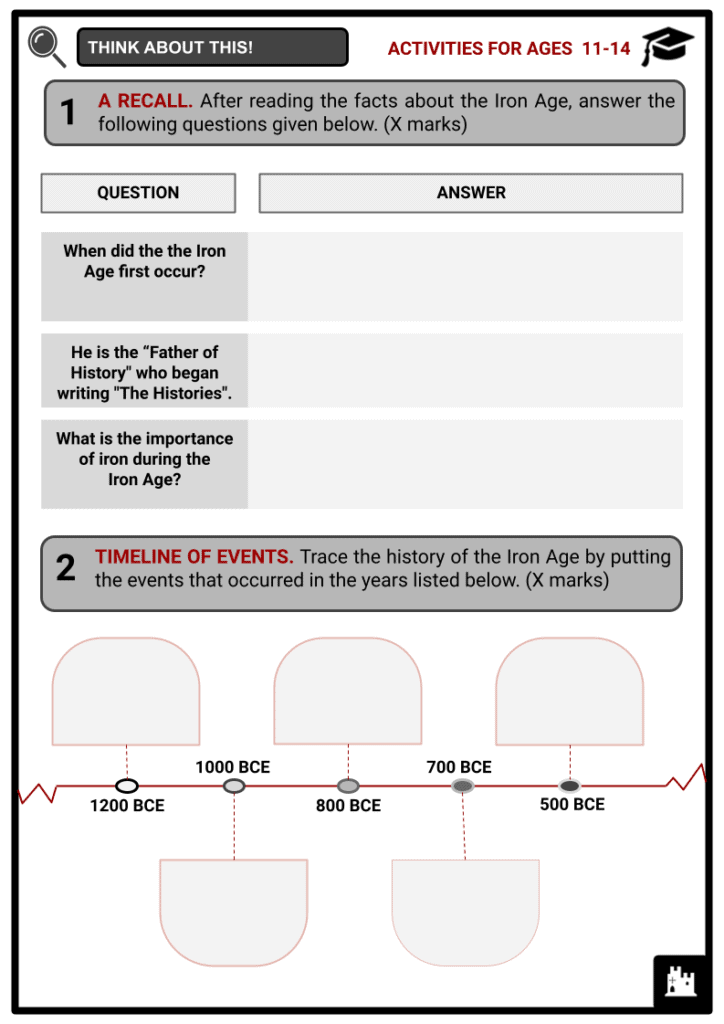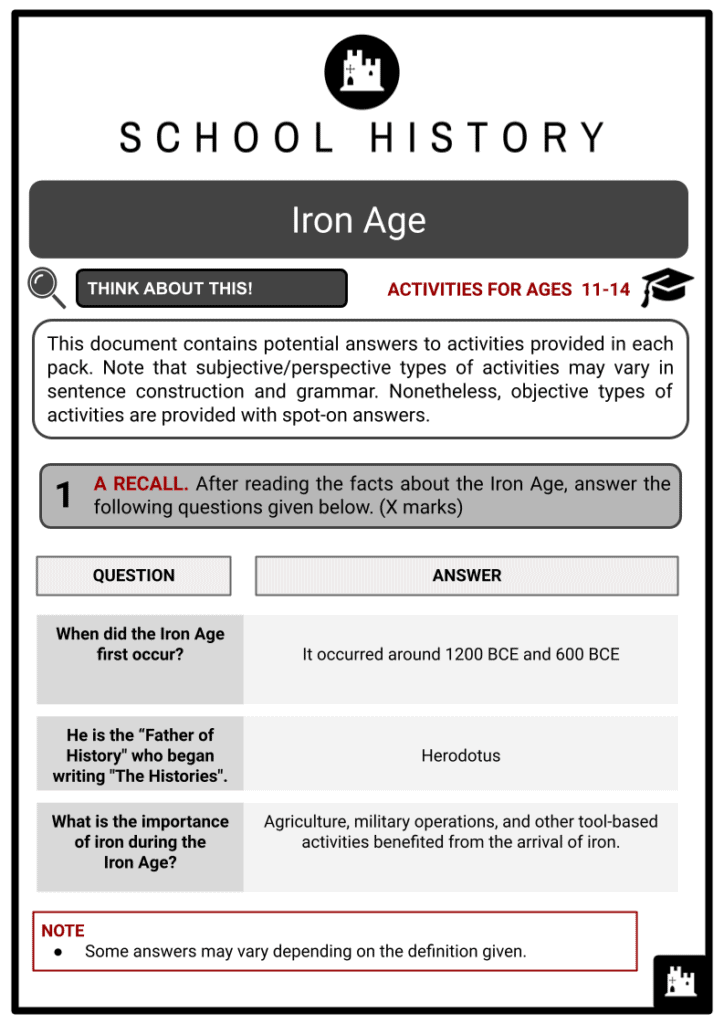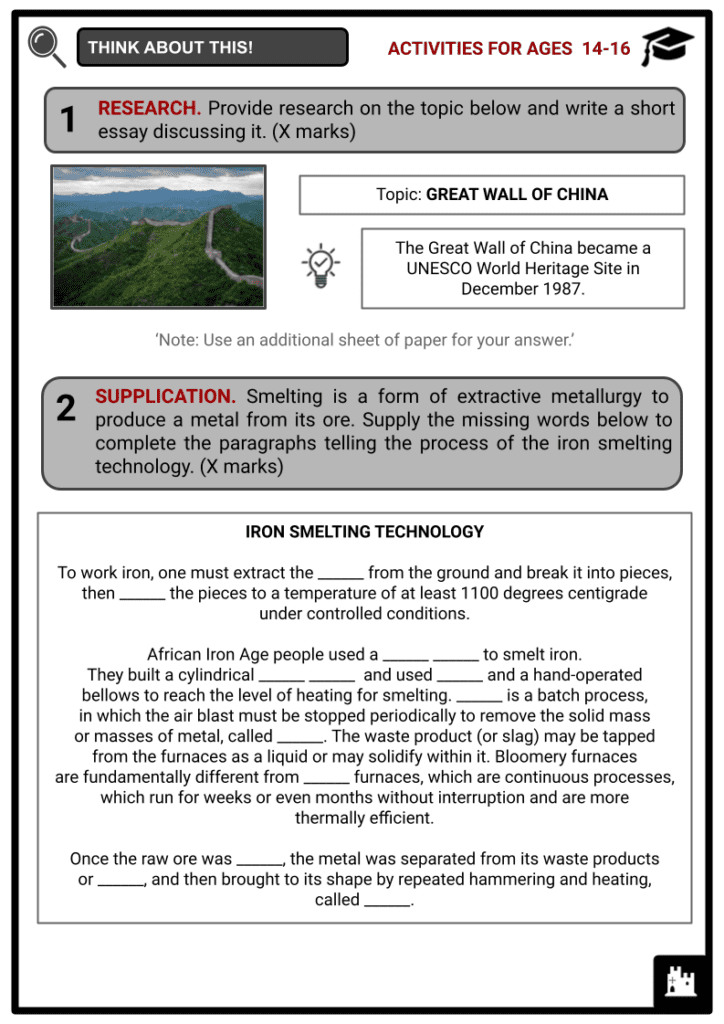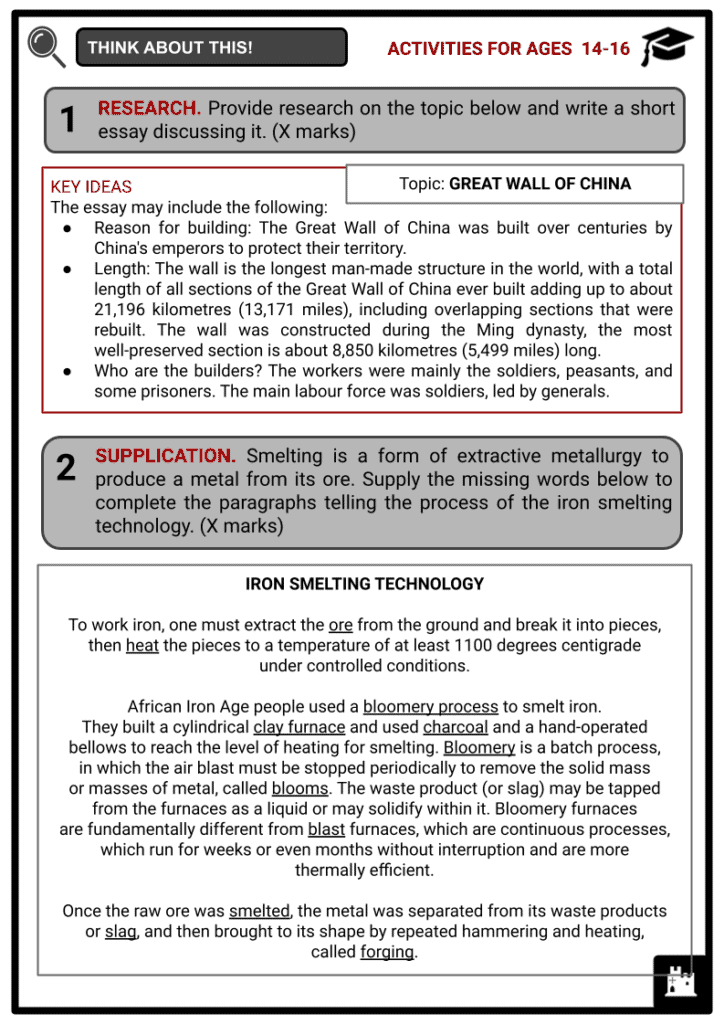Iron Age Worksheets
Do you want to save dozens of hours in time? Get your evenings and weekends back? Be able to teach about the Iron Age to your students?
Our worksheet bundle includes a fact file and printable worksheets and student activities. Perfect for both the classroom and homeschooling!
Summary
- Beginning of the Iron Age
- Duration of the Iron Age
- Characteristics and Importance
Key Facts And Information
Let’s find out more about the Iron Age!
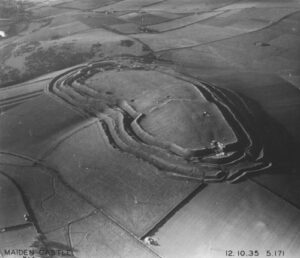
The Iron Age was a time in human history that began around 1200 BCE and 600 BCE, depending on the region. The Stone Age and Bronze Age were followed by the Iron Age. People in much of Europe, Asia, and portions of Africa began producing tools and weapons out of iron and steel during the Iron Age.
After mankind discovered how to manufacture steel, a much harder metal, by heating iron with carbon, the use of iron became more prevalent. The Hittites, who lived in what is now Turkey during the Bronze Age, may have been the first to produce steel.
Beginning of Iron Age
- The Iron Age began in the Mediterranean region and the Near East around 1200 BCE with the collapse of numerous prominent Bronze Age civilisations, such as the Mycenaean civilisation in Greece and the Hittite Empire in Turkey.
- The cause of these Bronze Age civilisations' demise is yet unknown. Between 1250 to 1100 BCE, archaeological evidence reveals a 150-year era of severe droughts in the eastern Mediterranean region, which probably played a significant role in the collapse. Earthquakes, starvation, societal turmoil, and nomadic tribe invasions could have all played a part.
- Some researchers assume that a disturbance in trade lines around this time resulted in a lack of the copper or tin necessary to create bronze. As a result, metalsmiths may have resorted to using iron.
- People in Britain learned how to use iron around 800 BCE This development had a huge impact on people's lives.
- The end of the Iron Age is generally dated at around 550 BCE, when Herodotus, "The Father of History," began writing "The Histories," though the exact date varies by region. With the rise of the Vikings in Scandinavia, it came to an end around 800 CE. The end of the Iron Age is usually associated with the Roman conquest in the first century BCE in Western and Central Europe.
- Greek Dark Ages
- During the late Bronze Age, Greece had become a prominent centre of activity and civilisation in the Mediterranean. Trade brought material richness to the Mycenaean civilisation. The Mycenaeans created massive palaces and a civilisation based on severe class divisions.
- However, circa 1200 BCE Mycenaean Greece was destroyed. Greece endured a turbulent period known as the Greek Dark Ages.
- According to archaeologists, there may have been a period of famine during which Greece's population numbers plummeted substantially. With the exception of Athens, major cities were abandoned. People relocated to smaller, more pastoral groupings focused on keeping cattle when urban cultures fractured.
Duration of Iron Age
- The Greeks of the early Iron Age did not leave any written records, leading some researchers to conclude they were illiterate. Few artefacts from the period, which lasted about 300 years, have survived.
- The Greek economy had recovered by the late Iron Age, and Greece entered its classical period. The Parthenon, Greek theatre, and philosophers such as Socrates were all part of Classical Greece's cultural triumphs.
- A political change occurred during the classical period, and the globe was introduced to a new style of governance known as ‘demokratia’, or "rule by the people."
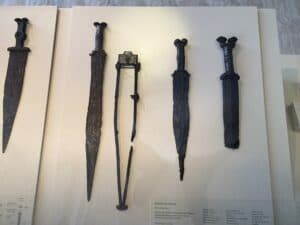
Celtiberian swords with antennas in Madrid’s museum. - The Iron Age began between 1200 BCE and 600 BCE. During this time, humans in Asia, Africa, and Europe began to make iron and steel tools and weapons.
- Humans may have melted some iron during the Bronze Age, believing it to be a lesser metal. Bronze tools and weaponry are significantly superior to iron ones.
- The Hittites, who lived in what is now Turkey, were the first people to use steel. They discovered that heating iron with carbon makes it harder, allowing it to be used for a variety of purposes.
- The age differs by region. According to archaeological norms, the presence of a few ironworkers is insufficient to represent its culture. When iron and steel manufacturing reached a stage where iron tools and weapons topped their bronze counterparts, the "Iron Age" began.
- The beginning of the historical convention also marks the end of the Iron Age. The Achaemenid Empire (considered historical based on reports by Herodotus) was created around 550 BCE in the ancient Near East, and the Roman conquest of Central and Western Europe in the first century BCE signalled the end of the Iron Age in Central and Western Europe. It is used to bring the Germanic Iron Age in Scandinavia to a close, with the start of the Viking Age in 800 CE.
- In the entire region, there is no clear cultural divide between the 13th and 12th centuries BCE. Although certain new features in the hilly terrain, Transjordan, and the coastline region may indicate the Aramian and Sea People groups' presence.
- The Iron Age as an archaeological period is defined as the period in a culture's or region's antiquity when iron metallurgy was the primary metalworking method.
- The Iron Age in the ancient Near East was traditionally dated from 1200 BCE (the end of the Bronze Age) to 550 BCE (or 539 BCE), about the start of historiography with Herodotus and the end of the proto-historical period. In Central and Western Europe, the Iron Age is pushed from the first C to the last. In Northern Europe, from around about 800 BCE to 1 BCE, and from around 500 BCE to 800 CE.
- Iron Ages in Other Regions. Let's look at when the Iron Age happened in various parts of the world.
- Africa - The African Iron Age, also known as the Early Iron Age Industrial Complex, is the period in Africa when iron smelting was conducted between the second century CE and around 1000 CE. Unlike Europe and Asia, Africa did not have a Bronze or Copper Age before the Iron Age; instead, all metals were brought together.
- To smelt iron, the African Iron Age people use a bloomery process. Following the smelting of the raw ore, the metal was separated from its waste products, or slag, and shaped by repetitive hammering and heating, a process known as forging.
- China - Despite the fact that iron technology initially arrived in China around 500 BCE, it was hardly utilised for the first three centuries. During the Warring States Period, when rulers of various kingdoms strove for control, China's Iron Age formally began in the late 3rd century to early 2nd century BCE. Iron bells, jars and vases, swords, and jewellery were all created by the Chinese utilising a casting procedure.
- Europe - The demise of the Bronze Age in the ancient Near East, ancient India (together with the Rigvedic Vedic culture), ancient Iran, and ancient Greece is considered as part of the rise of the Iron Age in Europe (Greek Dark Ages with). The Iron Age began in other parts of Europe in the eighth century BCE in Central Europe and the sixth century BCE in Northern Europe. Iron seems to have initially appeared in Eastern Europe circa 1000 BCE as a result of interaction with the Middle East and Asia Minor. The most important dissemination of the technology happened between 800 and 600 BCE as part of the Hallstatt civilisation, also known as the Celts. The Celts spread across Europe and into Britain owing to the superiority of iron weapons, which they acquired from their home in the Alps. Around 700 BCE, iron was in wide use across Europe.
- The Iron Age in the Near East is divided into two periods, Iron I and Iron II. Iron I (1200–1000 BCE) demonstrates both continuity and dissatisfaction with the previous Late Bronze Age.
- India - Even though archaeologists discovered evidence of iron technology in India as early as 1800 BCE, hundreds of years before the earliest evidence of Hittite iron, bronze remained the primary tool-making material for a long time. This prevented India from entering the Iron Age for hundreds of years, not due to a lack of technological understanding, but due to a lack of use. After discovering a putative location of industrial smelting, archaeologists today argue the probability of commencement in the 13th century BCE. By the 2nd century CE, Indian ironworkers were using the crucible to make high-quality steel by adding carbon to iron ore, regardless of when it began.
Characteristics and Importance
- The Iron Age's principal characteristic was iron, as its name suggests. Bronze, a copper-tin alloy, was the most common metal used to make tools in most areas.
- If tin had not been so scarce, bronze would have remained the dominant material in Western civilisation. The acute scarcity of tin prompted a dramatic decrease in bronze tool and weapon manufacture between 1800 and 1700 BCE. Copper began to run out around the same period. Pirates and raiders began raiding villages in the hopes of stealing any bronze they might find.
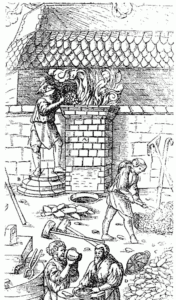
Bloomery smelting during the Middle Ages. - People are likely to have experimented with other metals as a result of the shortage. Although iron was more abundant than copper and tin, it melted at a far greater temperature than bronze. This meant they couldn't make the same tools out of iron. They could make the iron softer and shape it with hammers by heating it. People devised ways to raise the temperature of furnaces over time by employing bellows to pump oxygen into them. This allowed people to cast iron items, and later, carbon was added to make steel. They also discovered that rather than having to rebuild an object when it lost its edge, iron implements could be sharpened.
- The arrival of iron benefitted agriculture, military operations, and other tool-based activities even more than the introduction of bronze. The availability of iron alleviated the problem of bronze material scarcity. Farmers could break up the toughest soils and develop cropland by using stronger plough blades. Soldiers didn't have to recast their swords when they became dull; instead, they simply ground the edges back to a sharp point, saving money on equipment and weaponry. Metallurgists were also compelled to invent new methods of smelting and working with metals due to the technology required to work with the iron.

